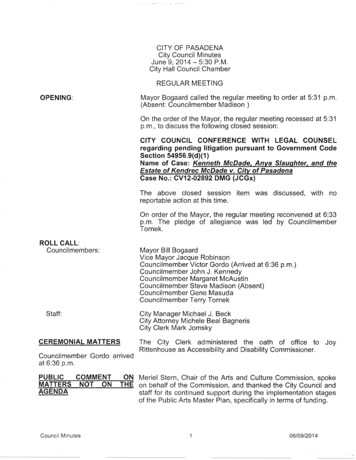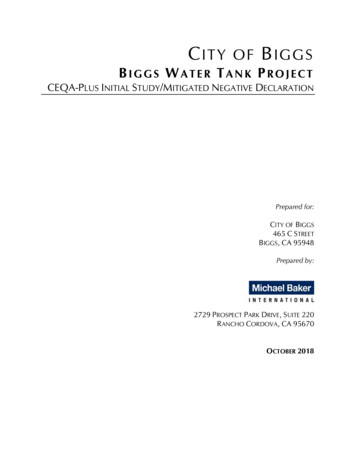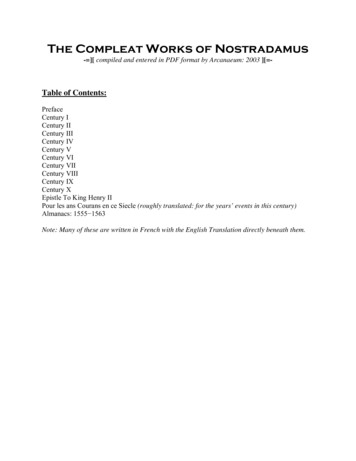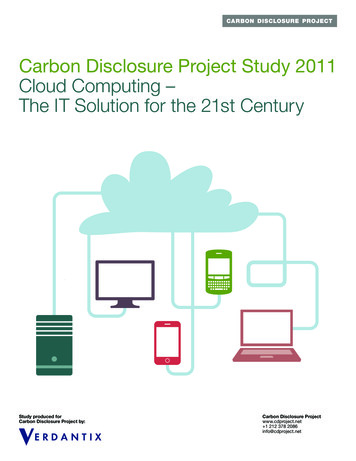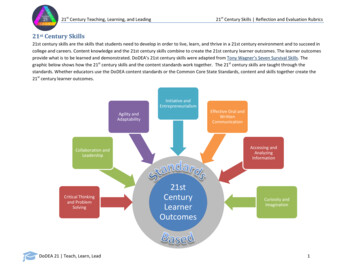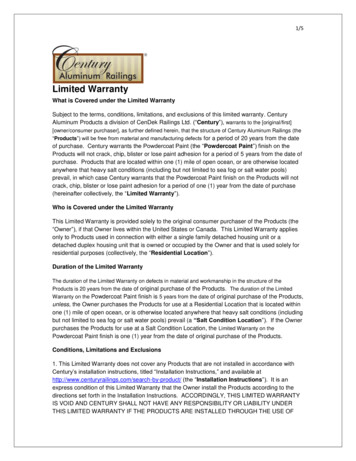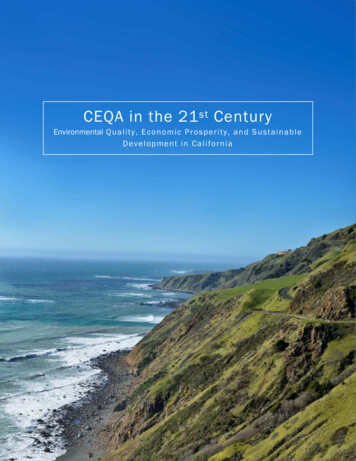
Transcription
CEQA in the 21 st CenturyEnvironmental Q u a l i t y , E c o n o m i c P r o s p e r i t y , a n d S u s t a i n a b l eDevelopment in California
This report was commissioned by theRose Foundation for Communities and the Environment.The Rose Foundation promotes community-based advocacy toprotect the environment, public health and consumers.Prepared by BAE Urban Economicswww.bae1.comAugust 2016All photographs unless otherwise credited, courtesy of Michael Smith-Heimerwww.mash-production.com
AcknowledgmentsThis report would not have been possible without the dedication and diligence ofenvironmental experts from across California who served as reviewers. We gratefullyacknowledge the following reviewers:Ethan ElkindDirector of the UCLA Law/UC Berkeley Law Climate Change and Business ProgramSean B. HechtCo-Executive Director, Emmett Institute on Climate Change and the Environment, UCLA Schoolof LawDaniel P. SelmiProfessor of Law, Loyola Law SchoolProject TeamJanet Smith-Heimer, MBABAE PresidentJessica Hitchcock, MCPBAE Vice PresidentPaige Roosa, MCPBAE AssociateChelsea Guerrero, MCPBAE AssociateThe BAE project team is solely responsible for the contents of this report.
Table of ContentsExecutive Summary . i1: Introduction and Study Purpose . 1Introduction . 1Study Purpose . 1Study Framework . 3Study Methodology . 32: Overview of CEQA Process . 5Overview of CEQA Process . 5Recent Legislative and Regulatory Changes to Streamline CEQA . 9Case Study: San Francisco’s Streamlined CEQA Process . 13CEQA’s Role in Achieving Environmental Justice . 153: CEQA Litigation: Number and Rate of Lawsuits . 19Number of CEQA Lawsuits 2002 - 2015 . 19Estimated Statewide CEQA Litigation Rates for 2013-2015 . 204: Direct and Indirect Costs of CEQA . 25Literature Review. 26Case Studies: Costs of CEQA Compliance . 285: California’s Economic Prosperity & Sustainability . 43Literature Review. 43Measures of Economic Prosperity . 44Measures of Sustainable Development and Infill . 49Appendix A: Estimate of CEQA Projects in California 2012- 2015 . 56Appendix B: List of Petitions Filed with Attorney General, 2012 – 2015 . 59Appendix C: Economic Data . 82Appendix D: About BAE . 89
Table of TablesTable 1: San Francisco CEQA Projects, 2013 - 2015 . 13Table 2: CEQA Lawsuits in California, 2013 - 2015 . 21Table 3: Litigation Rate, California, 2013 - 2015 . 22Table of FiguresFigure 1: General CEQA Compliance Flow Chart. 5Figure 2: San Francisco Community Plans. 14Figure 3: CEQA Lawsuits in California, 2002 - 2015 . 19Figure 4: Top 5 Fastest Growing States, Employment 2012 - 2015 . 44Figure 5: Gross Domestic Product (GDP) Top 5 States, 2015 . 45Figure 6: GDP Growth, Top 5 Largest GDP States, 2012-2015 . 45Figure 7: Median Household Income, Top 10 States, 2014. 46Figure 8: Median Household Income Growth, Top 15 States, 2011-2014 . 46Figure 9: Manufacturing Employment, Top 10 States, 2012 & 2015 . 47Figure 10: Manufacturing Jobs Added, Top 10 Largest Manufacturing States, 2012 - 2015 . 48Figure 11: Population Density per Square Mile, Top 15 States, 2010 . 49Figure 12: Change in Population Density Per Square Mile, 1970 - 2010 . 50Figure 13: New Home Construction Defined as Infill, 2000 - 2009 . 51Figure 14: Highly Ranked California Cities - Walk Scores 2015 & 2016 . 52Figure 15: California Cities with ParkScores Above the US, 2016 . 53Figure 16: LIHTC Units Produced per 100,000 Population, Top 10 States, 2014 . 54
Executive SummaryIntroductionThe California Environmental Quality Act (CEQA), signed into law by Governor Ronald Reagan in1970, requires state and local agencies to identify the potentially significant environmentalimpacts of proposed plans and development projects, and then to avoid or mitigate thoseimpacts when feasible.This sweeping law, in effect for more than 45 years, has profoundly affected California’senvironmental quality. Perhaps most importantly, the procedures built into CEQA compliance—requiring public notices, public comment periods, and agency responses to comments—worktogether to “daylight” virtually all major project proposals and plans. The CEQA process thusengages the public and governmental agencies in civic discourse about the environmentaleffects of physical development and land use policies affecting communities throughout thestate.Because no state agency is specifically empowered to enforce or implement CEQA’srequirements, either through court action or through administrative action beyond thepromulgation of guidelines, CEQA’s effectiveness depends largely on litigation by privateparties acting in the public interest. Without private enforcement, CEQA’s provisions could beviolated with impunity.Study Purpose and FrameworkCEQA is meant to encourage thoughtful, informed, transparent decision-making in a way thatlessens the environmental harm of projects and plans as they move forward. CEQAcompliance creates a process for the public, environmental and public health trustee andregulatory agencies, and other stakeholders to ensure accurate environmental impactanalysis, consideration of project alternatives, and adoption of feasible mitigation measuresfor a project’s significant impacts. Importantly, CEQA also requires an examination ofcumulative impacts, thereby stimulating debates around issues such as disproportionatelyimpacted communities, climate change, water supply, growth management, loss of farmlandor forestland, effects on endangered or protected animal species, and a host of other impacts.Yet, despite the informational and substantive advantages CEQA provides, the concept ofconducting environmental impact review through analysis and public comment is consistentlyraised by some developers, who object to the additional steps and costs involved in obtaining[i]
development approvals1. Anti-CEQA campaigns thus arise periodically, with critics claimingthat CEQA is being “abused.” Some members of the development community have assertedthat environmental review is too expensive, and unnecessarily delays or even kills importantprojects intended to advance California’s policy objectives. Special interests also expressconcern about litigation under CEQA— or even the threat of litigation— in the event a publicagency mismanages a procedural step or fails to conduct sufficiently comprehensive analysis.Because of these built-in tensions around environmental review costs, time delays, andoutcomes, there have been periodic calls for “CEQA reform” throughout the law’s existence.This report was designed to closely examine the arguments and assumptions underlying themost current calls for changes to the law.Key FindingsThe number of lawsuits filed under CEQA has been surprisingly low, averaging 195 per yearthroughout California since 2002. Annual filings since 2002 indicate that while the number ofpetitions has slightly fluctuated from year to year, from 183 in 2002, to 206 in 2015, there isno pattern of overall increased litigation. In fact, litigation year to year does not trend withCalifornia’s population growth, at 12.5 percent overall during the same period.The rate of litigation compared to all projects receiving environmental review under CEQA isalso very low, with lawsuits filed for fewer than 1 out of every 100 projects reviewed underCEQA that were not considered exempt. The estimated rate of litigation for all CEQA projectsundergoing environmental review (excluding exemptions) was 0.7 percent for the past threeyears. This is consistent with earlier studies, and far lower than some press reports aboutindividual projects may imply.In San Francisco, just 14 EIRs were prepared in the past three years (less than 5 EIRs peryear). The case study of San Francisco provided in this report highlights how, contrary tocritics’ claims, at least one of California’s major cities routinely uses the streamliningprocedures encouraged and built into CEQA statutes and guidelines.Despite critics often citing CEQA as a “major barrier to development,” no evidence supportsthat assertion. There are no studies available which quantify the cost of CEQA compliance orits impact on development projects.1 The costs of environmental review are usually charged by the lead public agency to the project applicant in casesof development projects.[ii]
To provide a contemporary sense of CEQA’s costs as well as the overall outcome from CEQA’smandated environmental reviews, this study examines five “case study” projects, includingfour that were not litigated, and one that was. The four non-litigated projects include a majortransit and intermodal center, an affordable senior housing project, an updated Specific Planfor a transit-oriented development (TOD), and a major solar energy installation.Each of these projects highlights facets of the CEQA process, and how it can benefitcommunities in which the project was located. For example, in Richmond, the EIR for a seniorhousing project determined that the site contained important cultural resources related to theJapanese-American internment during WW II.Direct environmental review costs for these four projects ranged from 0.025 to 0.5 percent oftotal project costs. Time periods for environmental review of these four projects ranged from10 to 29 months, with the longest occurring in the Richmond senior affordable housingproject. This lengthy review period was caused by the need to conduct several importantspecial studies addressing important effects uncovered during initial environmental review,including air quality measurements to mitigate health impacts of the site’s location next to afreeway.A fifth case study profiles the Southern California International Gateway (SCIG) railyard project,designed to serve both the Port of Los Angeles and the Port of Long Beach. Seven publicagencies and community groups successfully brought a lawsuit principally on environmentaljustice grounds, to ensure adequate environmental analysis of traffic, noise, and air pollutionimpacts on the adjacent West Long Beach low income neighborhood. This example illustrateshow CEQA can give a strong voice and provide protections to disadvantaged communities.When the Lead Agency reconsiders the project in light of the corrected environmental analysis,it is likely to require additional mitigation to protect these communities.[iii]
California consistently ranks among the top states in terms of economic prosperity andsustainable development. These rankings clearly demonstrate that California's strongframework of environmental protections, including CEQA, does not constrain growth andindeed helps ensure the state’s future sustainability. The following metrics paint a compellingpicture:Economic Prosperity California’s strong job growth ranked 5th among 50 states in past three years(California’s employment grew by 8.9 percent). California’s Gross Domestic Product (GDP), which is the value of all economic output,ranked 1st in the U.S. in 2015. The state’s rate of GDP growth in the past three yearsalso ranked 1st in the nation. California had the 9th highest median household income of all 50 states in 2014.California’s increase in median household income ranks 13th among the 50 statesbetween 2012 and 2014. California’s manufacturing sector, which some CEQA critics assert has been decliningand thus constraining household incomes for middle-income workers, in fact has thelargest number of jobs in manufacturing of the 50 states, with over 1.28 millionmanufacturing jobs in 2015. California has also increased manufacturing employmentby almost 38,000 jobs in the past three years, closely matching national growth ratesand contributing 9.8 percent of all new manufacturing jobs added to the US economysince 2012.Sustainable Development With more than 239 people per square mile, California ranked as the 11th mostdensely-populated state in the country in 2010. Its rate of upward densification since1970, when CEQA was enacted, places California 13th among the 50 states inincreased densification rates over 40 years. The pace of new residential construction considered as “infill” in California’smetropolitan areas compares favorably with other states. One study found that 80percent of new residential units built in the San Jose-Sunnyvale-Santa Clarametropolitan area between 2000 – 2009 were infill development. In contrast, just 7percent of new residential units built in Austin, Texas (with little environmental review)were infill development during the same period.[iv]
Metropolitan areas in California and New York have the greatest percentages of newinfill housing development. This pattern has occurred despite the presence ofextensive environmental review requirements in both California and New York. California has 12 of the top 50 most walkable cities in the U.S., a key metric forsustainable development, based on Walk Scores for more than 2,500 cities. Rankingsincluded San Francisco (#2 nationally), Oakland (#9), Long Beach (#10), and LosAngeles (#13). An analysis of changes in Walk Scores for 2015 to 2016 shows that allof these cities (and many other California cities) increased their scores as well,indicating ongoing improvements in pedestrian orientation. A new metric by Trust for Public Land ranks the largest 100 U.S. cities in terms of parkavailability and other park-related factors. Eight cities in California scored higher thanthe national average for these 100 cities, including San Francisco, which ranked 5thamong all cities scored. California’s affordable housing production, measured by the number of units receivingLow Income Housing Tax Credits (LIHTCs), shows the state ranking 9th highest per100,000 of population in 2014. This is the best available metric of California’saffordable housing production to compare across all 50 states, since LIHTCs areavailable on a per-capita basis across all states per federal law.In summary, a broad look at the evidence shows that litigation under CEQA has not increasedsince 2002, a fact that rebuts assertions that the vast majority of projects in California arenow subject to lawsuits. Furthermore, CEQA has been amended to institute streamliningprocedures, and the evidence from San Francisco indicates that a very high percentage ofapprovals are subject to exemptions from CEQA, and that the number of EIRs prepared issmall. Importantly, while critics claim that CEQA is constraining the California economy, keymetrics show the strength of California's economy, rebutting that assertion. Finally, Californiaalso ranks high in sustainable development indicators, an outcome that almost certainlyreflects CEQA's requirement that public agencies analyze environmental effects and mitigatethem where feasible.[v]
1: Introduction and Study PurposeIntroductionPassed in 1970 as a state counterpart to the National Environmental Policy Act (NEPA), theCalifornia Environmental Quality Act (CEQA) requires state and local agencies to identify thepotentially significant environmental impacts of their actions, and then to avoid or mitigatethose impacts if feasible.State and local public agencies must comply with CEQA for each "project," which is defined asan activity undertaken by a public agency, or an activity by a private entity subject to publicagency discretionary approval, that may cause either a direct physical change in theenvironment or a reasonably foreseeable indirect change in the environment. Most proposedphysical developments in California, as well as land use plans and regulations (e.g., GeneralPlans, Zoning Ordinances, Specific Plans, etc.), are subject to CEQA unless an exemptionapplies.The required environmental review involves both procedural and substantive steps,commencing with an initial review of the proposed project and its environmental effects.Depending on the potential effects, more substantial review may occur through preparation ofan Environmental Impact Report (EIR).This sweeping law, in effect for more than 45 years, has profoundly affected California’senvironmental quality. Perhaps most importantly, the procedures built into CEQA compliance,which require public notices, public comment periods, and responses to those comments,work together to “daylight” development proposals and plans, engaging the public and othergovernmental agencies in civic discourse about the environmental effects of physicaldevelopment and land use policies.Study PurposeThis study was designed to provide a thoughtful examination of the arguments andassumptions underlying current criticisms of CEQA. Since CEQA’s adoption over 45 years ago,certain organizations and interest groups have balked at the Act’s environmental reviewprocess, public comment requirements, and occasional litigation, claiming that theseadditional steps create significant barriers to business and development.[1]
Though these arguments against CEQA have taken many different forms over the years, thelatest cries for CEQA “reform” largely fall into three general categories: “Abuses” of the Process through Litigation. Some studies assert that CEQA is“abused” by those seeking to stop worthy projects. According to these critics, thealleged abuses have caused a cumulative negative effect on housing markets, trafficconditions, job growth, and other metrics of the economic vitality of California. Somecritics have also asserted that specific aspects of the litigation process under CEQA,such as lack of transparency in identification of petitioners, also contribute to thisalleged abuse. Burdensome Project Costs and Delays. Some critics object to the cost ofenvironmental review, which is usually charged to the project applicant. In cases ofprivate real estate development projects requiring preparation of an EIR, both the costand the time to prepare the document up to final adoption, can seem burdensome.Similar costs and delays can also affect public infrastructure projects such majortransportation improvements. Constraints on Other Policy Initiatives. Calls for reform also come from advocates ofother important policy initiatives such as affordable housing production, sustainableand infill development, transit system improvements, and large renewable energyprojects. Critics claim that CEQA compliance can delay or even thwart these projects.The California Legislature frequently considers and adopts legislation to refine and focusCEQA, seeking to align it more closely with other policy initiatives. Nevertheless, many of thecurrent calls for reform would rewrite essential components of CEQA, threatening in effect toundo or compromise the entire concept and process behind the statute.This report focuses on literature review and primary data to closely assess the claimsunderlying the current calls for CEQA reform. The report documents contemporary practices ofenvironmental review, CEQA litigation rates, costs of development projects, and California’soverall status within the nation in terms of economic prosperity and sustainable development.The report is not intended to be an exhaustive policy analysis of the full costs and benefits ofCEQA, and it does not address or set forth particular reform initiatives. It does, however,directly address the major criticisms of CEQA.[2]
Study FrameworkIn order to provide an empirical basis for evaluating CEQA’s role in California’s economic andsustainable development landscape, this report focuses on three key questions: How many lawsuits have been filed annually under CEQA since 2002, the first year forwhich litigation data is readily available?2 What is California’s current rate of CEQAlitigation relative to all CEQA projects involving Environmental Impact Reports, NegativeDeclarations, and Mitigated Negative Declarations? What are the direct costs of CEQA compliance relative to overall project developmentcosts? How do time delays or other indirect effects of the CEQA review process impactthe development process? Has California’s framework of environmental protections (including CEQA) constrainedits economic prosperity or ability to develop in a sustainable way?These key questions are a central focus of elected officials, environmental professionals, anda wide range of activists who both support and object to CEQA as currently implemented.While other articles, opinion pieces, and studies have raised these questions, those writingslack sufficient documentation and analysis.Study MethodologyThe methodology used for this report includes the following approaches to address the threestudy questions: Literature review of prior empirical studies. Primary research in the form of quantitative analysis of litigation rates and case studyresearch for other issues. Quantitative review of published metrics for California and benchmark jurisdictions toprovide recent data regarding CEQA’s effects on statewide prosperity and sustainabledevelopment.Each chapter of this report provides further description of the methodologies employed toanalyze each key question.2 David Petit and Tom Adams, “The Litigation Myth,” National Resources Defense Council, 2013. This analysisincludes litigation tallies for 2002 – 2012 based on data provided by the Office of the Attorney General.[3]
2: Overview of CEQA ProcessThis chapter provides a description of the CEQA process, which has evolved since its initialpassage in 1970 through a series of legislative reforms, updated regulatory guidelines, andcourt cases. This chapter also highlights how the CEQA process, with streamlining proceduresin place, has been utilized in the City and County of San Francisco in recent years.Overview of CEQA ProcessThe chart below summarizes the CEQA compliance process, with additional explanations ofeach step on the following pages. Those readers familiar with CEQA may skip to Chapter 3 ofthis report.Figure 1: General CEQA Compliance Flow Chart1: DoesCEQAApply?5: LeadAgencyCerficiation3: EnvironmentalReview4: PublicNotice,Review, &Comment2: InitialStudySource: BAE, 2016.Step 1: Determine Whether CEQA AppliesCEQA applies to any activity that qualifies as a “project,” which is defined as an actionundertaken by a public agency, or by a private entity that requires discretionary approval froma public agency, and that may cause foreseeable physical changes to the environment.Projects include development proposals, activities undertaken by public agencies that canresult in physical development (e.g., General Plans or Specific Plans), and activities with publicagency assistance such as grants or loans.The public entity (e.g., city or county) carrying out its own project—or in the case of a privateproject, the public agency responsible for approving the project—must spearhead theenvironmental review as the “Lead Agency.”[5]
ExemptionsNot all projects are subject to CEQA. The State Legislature has carved out exemptions to CEQAthat fall into two categories: statutory and categorical exemptions. Statutory exemptions areactivities the Legislature has specifically excluded from CEQA despite any environmentalimpacts.3 Examples include Caltrans activities related to restriping streets or highways, orprojects necessary to prevent or mitigate an emergency. Categorical exemptions includeclasses of projects that have been determined generally not to have significant impacts on theenvironment. There are currently 33 types of categorical exemptions, which includeministerial approvals (e.g., replacing windows), new construction of small structures, andminor alterations to land.Categorical exemptions are not absolute, and a project in a class that does not ordinarily resultin significant impacts may, in certain sensitive environments, create significant impacts.Therefore, projects ordinarily subject to a categorical exemption may undergo environmentalreview if there is adequate evidence of a possible adverse impact due to unusualcircumstances.Step 2: Initial StudyIf a project is subject to CEQA and no exemption applies, the Lead Agency must prepare anInitial Study to determine whether the project may have any significant environmental impacts.The purpose of the Initial Study is to provide a preliminary analysis that determines if there is apotential for significant impacts.To assist lead agencies in determining whether a project may have a significant impact, theGovernor’s Office of Planning and Research (OPR) publishes a sample Initial Study form,Appendix G to the CEQA Guidelines, which sets forth a series of questions regarding a range ofpotential impacts.4 Topics include environmental considerations such as biology, greenhousegas emissions, and air and water quality, along with impacts on the built environment, such astraffic, views, noise, and public service infrastructure. The Initial Study, as well as all CEQAanalysis, must also consider a project’s potentially significant “cumulative impacts,” such asrelated impacts from other ongoing projects and impacts over time.3 According to Western Municipal Water District of Riverside County v. Superior Court of San Bernardino County(1986) 187 Cal. App. 3d 1104, “the self-evident purpose of a [statutory] exemption is to provide an escape fromthe EIR requirement despite a project’s clear, significant impact.”4 These questions are contained in Appendix G (Environmental Checklist Form) of the CEQA Guidelines, available athttp://resources.ca.gov/ceqa/guidelines/Appendix G.html.[6]
Step 3: Environmental ReviewThe lead agency next uses findings from the Initial Study to determine whether furtherenvironmental review is warranted. Within 30 days after accepting a completed application,the Lead Agency must determine which of the following review documents it intends toprepare:1. Negative Declaration: If the lead agency determines that there is no substantialevidence, in light of the whole record, to support a fair argument that the project mayhave a significant impact on the environment, it will issue a Negative Declaration.OR2. Mitigated Negative Declaration: If potential significant impacts are identified and thelead agency adopts revisions to the project that either eliminate all significant impacts,or reduce them to less-than-significant levels, a Mitigated Negative Declaration may beprepared.OR3. Environmental Impact Report (EIR): If the Initial Study finds that there is a fairargument that there is substantial evidence that significant effects may occur, then anEIR is required. An EIR must provide detailed information about a project’s anticipatedimpact on the environment, consider feasible ways to mitigate significant adverseenvironmental effects, and examine project alternatives that could feasibly lessen theimpacts.Step 4: Public Notice, Review, and CommentOne of the key features of the CEQA process is its emphasis on notification, outreach, review,and comment opportunities for members of the public. The process also includes notificationand review/comment by other affected public agencies. Each of the aboveactions/documents triggers a formal public notification and comment period with specifictimelines.Negative Declarations or Mitigated Negative DeclarationsFor Negative Declarations and Mitigated Negative Declarations, the Lead Agency must providethe public, relevant trustee agencies, and the County Clerk with a minimum 20-day review andcomment period. During that period, if substantial evidence is provided to support a fairargument that the project may have a significant effect that c
In San Francisco, just 14 EIRs were prepared in the past three years (less than 5 EIRs per year). The case study of San Francisco provided in this report highlights how, contrary to critics' claims, at least one of California's major cities routinely uses the streamlining procedures encouraged and built into CEQA statutes and guidelines.


